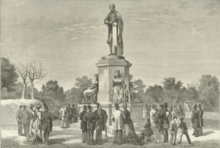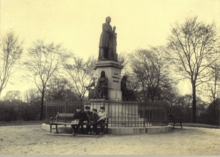Hans Christian Ørsted Monument
The Physicist Hans Christian Ørsted (Danish: Fysikeren Hans Christian Ørsted) is a monument to Hans Christian Ørsted located in Ørsted Park in central Copenhagen, Denmark.
| The Physicist Hans Christian Ørsted | |
|---|---|
.jpg) Monument to H. C. Ørsted | |
| Year | 1871 |
| Medium | Bronze |
| Subject | Hans Christian Ørsted |
| Location | Copenhagen |
| 55°40′51″N 12°34′03″E | |
Description
The monument consists of a bronze statue of Ørsted mounted on a granite plinth. Ørsted is seen demonstrating the effect of an electric current on a magnetic needle. With his hands he is connecting the wires from an electric battery, thereby making a magnet oscillate. At the foot of the statue sit the three Norns or goddesses of destiny in Norse mythology, Urðr (the past) who is noting the past, and Ørsted's name, on a tablet, Verðandi (the present), who with her distaff is spinning the thread of fate, and Skuld (the future), who is silently awaiting the fullness of time with a rune stick in her hand.[1]
At the base of the statue sit the three Norse Norns or goddesses of fate Urðr (the past), who is noting the past represented by Ørsted's name on a tablet, Verðandi (the present), who, with her distaff, is spinning the thread of fate, and Skuld (the future), who is silently awaiting the times that come with a runic stick in her hand.
History

.jpg)

The idea for the monument was conceived in early 1860 by Elisabeth Jerichau-Baumann as mentioned by Hans Christian Andersen in Mit livs eventyr. A committee was set up but it would take 16 years before the monument was inaugurated. The committee consisted of the politician Frederik Ferdinand Tillisch, professor Johan Georg Forchhammer, Ole Berendt Suhr and Hans Christian Andersen. The committee had its first meeting on 2 October 1981.[2] Jens Adolf Jerichau was given the task of designing the monument. Forchhammer died in 1865 and was replaced by J. C. Jacobsen in 1867. In 1873, they began to raise money for the bronze figures. They were cast in C. F. Holm's foundry at Gammel Mønt.[3] It was erected on the former Holck's Bastion, when work on the park just started. The statue was finally inaugurated on 25 September 1876.[4]
References
- "The Physicist Hans Christian Ørsted". Copenhagen Municipality. Retrieved 2011-02-01.
- "H.C. Andersen og Det Suhrske Hus (fortsat)". Den Suhrske Stiftelse (in Danish). Retrieved 23 May 2015.
- "Fysikeren Hans Christian Ørsted (1777-1851)". kk.sites.itera.dk (in Danish). Retrieved 23 May 2015.
- "1876". Selskabet for Københavns Historie (in Danish). Retrieved 23 May 2015.